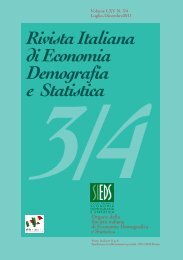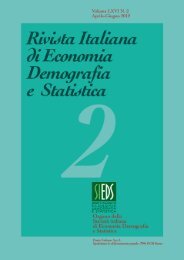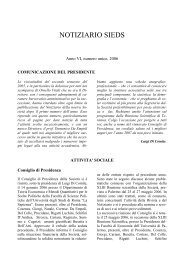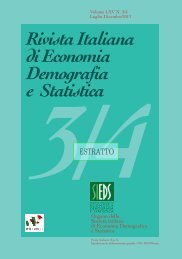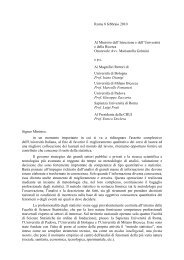rivista italiana di economia demografia e statistica - Sieds
rivista italiana di economia demografia e statistica - Sieds
rivista italiana di economia demografia e statistica - Sieds
Create successful ePaper yourself
Turn your PDF publications into a flip-book with our unique Google optimized e-Paper software.
58<br />
Volume LXIII nn. 3-4 – Luglio-Dicembre 2009<br />
The influence on rental prices by the duration of the contracts is a matter-of-fact effect.<br />
Miron (1990) states that the time <strong>di</strong>scount must be considered as a specific con<strong>di</strong>tion of<br />
the dwelling which may mo<strong>di</strong>fy the price of dwelling services received by the<br />
household, and must be taken into account in imputing rents. Consequently, we include<br />
the length of occupancy in the regression model to take tenure <strong>di</strong>scount into explicit<br />
account, to prevent an omitted variable problem. At the same time, we neutralize its<br />
effect when imputing rents. While the tenure is a basic control factor in the regression,<br />
it has to be excluded for pre<strong>di</strong>cting values as the opportunity cost is represented by the<br />
current value of the alternative.<br />
The estimated coefficients β in (4) are then multiplied by the values of the<br />
explanatory variables observed for the household j belonging to the other sub-groups,<br />
in order to obtain their correspon<strong>di</strong>ng value of IR. IR estimates for the owner-occupiers<br />
(O) is calculated as:<br />
y fig,j = exp (β 0 + β 1k X O kj + β 3 λ O j +σ 2 /2) (5)<br />
where the term β 2 *T i <strong>di</strong>sappears because T is settled to 0, in order to sterilize the effect<br />
due to the length of occupancy on the final estimates; the last term is the smearing<br />
estimator, where σ 2 is the estimated variance of the error term u: its inclusion prevents<br />
form the retransformation bias (Duan, 1983).<br />
The data used are from the Eu-Silc project; it is an instrument aiming at collecting<br />
timely and comparable multi<strong>di</strong>mensional micro data for in<strong>di</strong>cators on income, social<br />
cohesion and social exclusion. This instrument is anchored in the European Statistical<br />
System.<br />
4. Main results on overall income <strong>di</strong>stribution and inequality in<strong>di</strong>cators<br />
Due to space restrictions, we do not present the results on the probit and OLS<br />
models 2 . However, it is important to highlight that the selection bias seems to operate<br />
in every Country and for every subgroup, except for free tenants in IT and ES,<br />
supporting our decision to correct for such bias.<br />
We can now measure the impact of introducing IR on income. In table 1 the<br />
average <strong>di</strong>sposable incomes in the four Countries are presented, inclu<strong>di</strong>ng and not<br />
inclu<strong>di</strong>ng IR. Income is in the equivalent form, obtained through the OECD scale, at<br />
Purchasing Power Parities (PPP). If we use the average income with no IR for each<br />
Country as a baseline (column 3 of table 1) we notice increases with <strong>di</strong>fferent<br />
magnitudes across Countries (column 6 of table 1): the greatest increase is registered<br />
for ES (+29,9%) and the smallest for IT (+19%), compared to around +23% for UK<br />
and FR.<br />
2 The results are available on request from the authors.



